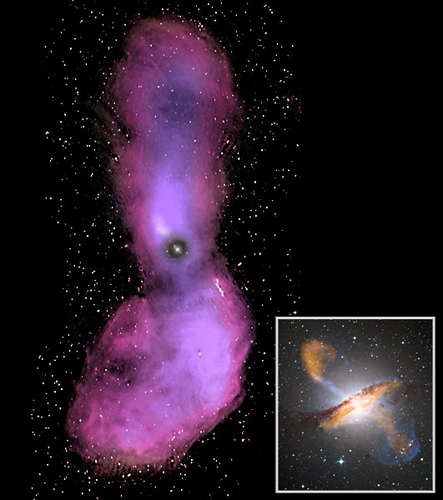The Influence of Dual Black Holes and Radio Galaxies within the Milky Way
Radio galaxies beam as much as one trillion solar-luminosities of radiation into space at radio wavelengths. They are therefore cosmic beacons, and the light from the most distant ones known was emitted back when the universe was only a few billions of years old (compared with its age today of about 13.7 billion years). The origin of this intense emission is thought to lie in the hot environment of a massive black hole at the galaxy’s nucleus, with the radio emission being produced by electrons moving rapidly in strong magnetic fields. Astronomers seeking to better understand galaxies in general, and the context of the Milky Way’s origins, want to know when and how radio galaxies formed, how they evolved, and how they impact their environments.
Luminous radio galaxies of course also contain stars. The relationship between the development of a radio galaxy’s stars and its nuclear black hole is still very uncertain. CfA astronomers Steve Willner and Giovanni Fazio, together with nine colleagues, used the Spitzer Space Telescope and its infrared cameras to study the warm, infrared bright dust in a large sample of seventy radio galaxies whose light has been traveling towards Earth for times spanning a range of between seven and one-half to twelve billion years — the cosmic epochs when astronomers think most galaxy maturation occurred.

The astronomers report that most of these galaxies completed the process of making the majority of their stars when the universe was only about two and one-half billion years old. They also find that differences in the infrared emission of the sample is consistent with the idea that their active nuclei are obscured by dust disks being observed at various angles. The team reaches one more notable conclusion. Four of the seventy galaxies show evidence in the images for a second supermassive black hole, suggesting that the origin of these galaxies (and perhaps the others as well during some earlier stage of development) was caused by the merger of two smaller galaxies.
In a completely separate article in the same issue of the Astrophysical Journal, CfA theoretical astronomers Yue Shen and Avi Loeb present an analysis of the spectral radiation signature of black hole binaries. If the black holes are actually orbiting around each other rather than just being close to one another, and presuming that each has an accretion environment emitting light, the scientists show that useful diagnostic evidence of that motion will be present in the shape of the spectral lines emitted — at least when the two black holes are orbiting fairly close together. The result, although not specifically addressing luminous radio galaxies with binary black holes, provides a new way to probe details of the black hole activity in galaxy nuclei.
This article is republished from PhysORG under a Creative Commons license. Read the original article.*
Do not forget to share your opinion with us to provide you with the best posts !



0 Comments